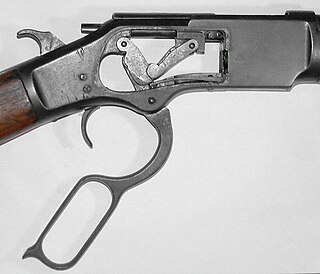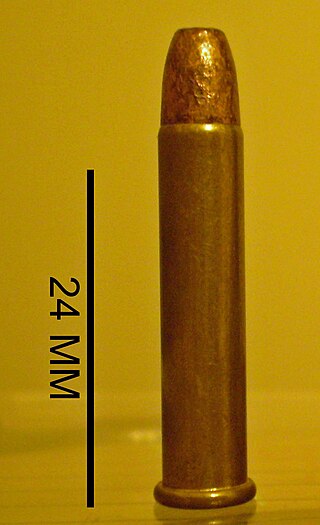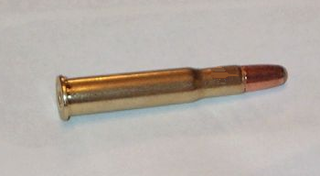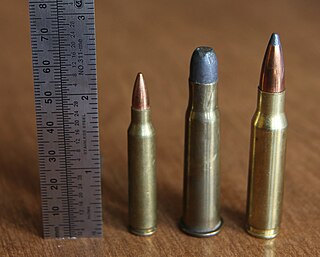Winchester rifle is a comprehensive term describing a series of lever action repeating rifles manufactured by the Winchester Repeating Arms Company. Developed from the 1860 Henry rifle, Winchester rifles were among the earliest repeaters. The Model 1873 was particularly successful, being marketed by the manufacturer as "The Gun That Won the West".

Lever action is a type of action for repeating firearms that uses a manually operated cocking handle located around the trigger guard area that pivots forward to move the bolt via internal linkages, which will feed and extract cartridges into and out of the chamber, and cock the firing pin mechanism. This contrasts to other type of repeating actions such as the bolt-action, pump-action, semi-automatic, fully automatic, and/or burst mode actions. A firearm using this operating mechanism is colloquially referred to as a levergun.

The .45 Colt (11.43×33mmR), is a rimmed, straight-walled, handgun cartridge dating to 1872. It was originally a black-powder revolver round developed for the Colt Single Action Army revolver. This cartridge was adopted by the U.S. Army in 1873 and served as an official US military handgun cartridge for 14 years, before being replaced by the .38 Long Colt in 1892.

The .32-20 Winchester, also known as .32 WCF , was the first small-game lever-action cartridge that Winchester produced. It was initially introduced as a black-powder cartridge in 1882 for small-game, varmint hunting, and deer. Colt produced a single-action revolver chambered for this cartridge a few years later.

The .44-40 Winchester, also known as .44 Winchester, .44 WCF, and .44 Largo, was introduced in 1873 by the Winchester Repeating Arms Company. It was the first metallic centerfire cartridge manufactured by Winchester, and was promoted as the standard chambering for the new Winchester Model 1873 rifle. As both a rifle and a handgun caliber, the cartridge soon became widely popular, so much so that the Winchester Model 1873 rifle became known as "The gun that won the West."

The .22 Winchester Magnum Rimfire, also called .22 WMR, .22 Magnum, .22 WMRF, .22 MRF, or .22 Mag, is a rimfire cartridge. Originally loaded with a bullet weight of 40 grains (2.6 g) delivering velocities in the 2,000 feet per second (610 m/s) range from a rifle barrel, .22 WMR is now loaded with bullet weights ranging from 50 grains (3.2 g) at 1,530 feet per second (470 m/s) to 30 grains (1.9 g) at 2,200 feet per second (670 m/s).
The Winchester Repeating Arms Company was a prominent American manufacturer of repeating firearms and ammunition. The firm was established in 1866 by Oliver Winchester and was located in New Haven, Connecticut. The firm went into receivership in 1931 and was bought by the Western Cartridge Company, a forerunner of the Olin Corporation. The Winchester brand name is still owned by the Olin Corporation, which makes ammunition under that name. The Winchester name is also used under license for firearms produced by two subsidiaries of the Herstal Group – FN Herstal of Belgium and the Browning Arms Company of Ogden, Utah.
The Henry repeating rifle is a lever-action tubular magazine rifle famed both for its use at the Battle of the Little Bighorn and being the basis for the iconic Winchester rifle of the American Wild West.

The .30-30 Winchester cartridge was first marketed for the Winchester Model 1894 lever-action rifle in 1895. The .30-30, as it is most commonly known, along with the .25-35 Winchester were offered that year as the United States' first small-bore sporting rifle cartridges designed for smokeless powder. Since its introduction, it has been surpassed by many cartridges in the long-range shooting attributes of speed, energy, and trajectory, yet remains in widespread use because of its practical effectiveness in forested hunting situations.

The Remington Model 14 was a pump-action repeating rifle designed for the Remington Arms company by John Pedersen. It is part of a series of rifles that include the Remington Model 14-1/2 and the Remington Model 141.
The Winchester Model 1894 rifle is a lever-action repeating rifle that became one of the most famous and popular hunting rifles of all time. It was designed by John Browning in 1894 and originally chambered to fire two metallic black powder cartridges, the .32-40 Winchester and .38-55 Winchester. It was the first rifle to chamber the smokeless powder round, the .30 WCF in 1895. In 1901, Winchester created the new .32 Winchester Special caliber with production of rifles starting in 1902.

The Marlin Model 1894 is a lever-action repeating rifle introduced in 1894 by the Marlin Firearms Company of North Haven, Connecticut. At its introduction the rifle came with a 24-inch barrel and was chambered for a variety of rounds such as .25-20 Winchester, .32-20 Winchester, .38-40, and .44-40. Variants in other chamberings remain in production today.
The .405 Winchester is a centerfire rifle cartridge introduced in 1904 for the Winchester 1895 lever-action rifle. It remains to this day one of the most powerful rimmed cartridge designed specifically for lever-action rifles; the only modern lever action cartridges that exceed its performance are the .50 Alaskan, .450 Alaskan, .475 Turnbull, .348 Turnbull, and the .450 Marlin. The .405 was highly regarded by U.S. President Theodore Roosevelt during his safari in East Africa.

The .33 Winchester Center Fire is a centerfire rifle cartridge designed and produced from 1902 to 1940 by Winchester Repeating Arms Company for their Model 1886 lever-action rifle.

The .219 Zipper cartridge was created by Winchester Repeating Arms in 1937 to be used in their lever-action Model 64 rifle. It is a 30-30 Winchester cartridge necked down to a .22 caliber bullet. Marlin Firearms also offered their Marlin Model 336 rifle chambered for the cartridge.
The Winchester Model 1886 was a lever-action repeating rifle designed by John Browning to handle some of the more powerful cartridges of the period. Originally chambered in .45-70 Government, .45-90 Sharps, and .40-82 Winchester, it was later offered in a half dozen other large cartridges, including the .50-110 Winchester. Despite being originally designed for use with black powder, the action was strong enough to make the jump to smokeless powder with only minor modifications, and was subsequently chambered in the smokeless .33 Winchester cartridge beginning in 1903.
The .38-72 Winchester, also known as .38-72 WCF is a rimmed, bottleneck centerfire rifle cartridge introduced in 1895 for the Winchester 1895 lever-action rifle.

The .40-72 Winchester, also known as .40-72 WCF is a centerfire straight-walled rifle cartridge designed for black powder rather than smokeless powder. It was introduced in 1895 for the Winchester 1895 lever-action rifle.

The .45-75 WinchesterCentennial is a centerfire rifle cartridge developed in 1876 for the newly designed Winchester Model 1876 Centennial lever-action rifle. Winchester Repeating Arms Company introduced the rifle and cartridge at the United States Centennial Exposition. The Model 1876 rifle used an enlarged version of the famous Winchester Model 1873 action to offer a lever-action repeating rifle using cartridges suitable for big-game hunting. The cartridge and rifle enjoyed brief popularity with Gilded Age American hunters including Theodore Roosevelt, and was issued to the Canadian North-West Mounted Police and to Texas Rangers.

The .45-60 Winchester is a centerfire rifle cartridge intended for 19th-century big-game hunting. Nomenclature of the era indicated the .45-60 cartridge contained a 0.45-inch (11.43 mm) diameter bullet with 60 grains (3.89 g) of black powder. Winchester Repeating Arms Company shortened the .45-70 Government cartridge to operate through the Winchester Model 1876 rifle's lever-action.















